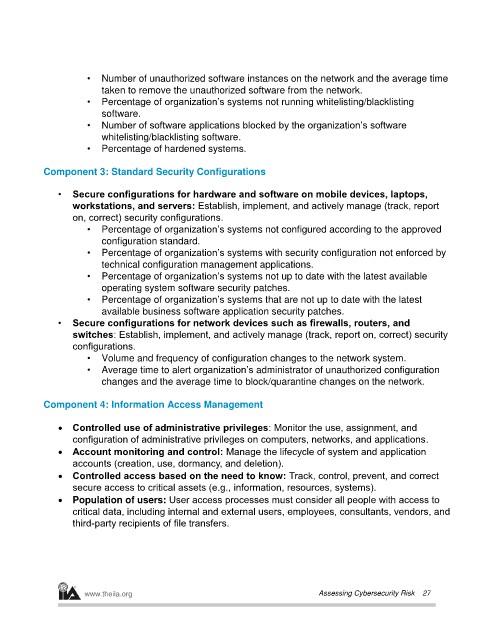Page 331 - ITGC_Audit Guides
P. 331
• Number of unauthorized software instances on the network and the average time
taken to remove the unauthorized software from the network.
• Percentage of organization’s systems not running whitelisting/blacklisting
software.
• Number of software applications blocked by the organization’s software
whitelisting/blacklisting software.
• Percentage of hardened systems.
Component 3: Standard Security Configurations
• Secure configurations for hardware and software on mobile devices, laptops,
workstations, and servers: Establish, implement, and actively manage (track, report
on, correct) security configurations.
• Percentage of organization’s systems not configured according to the approved
configuration standard.
• Percentage of organization’s systems with security configuration not enforced by
technical configuration management applications.
• Percentage of organization’s systems not up to date with the latest available
operating system software security patches.
• Percentage of organization’s systems that are not up to date with the latest
available business software application security patches.
• Secure configurations for network devices such as firewalls, routers, and
switches: Establish, implement, and actively manage (track, report on, correct) security
configurations.
• Volume and frequency of configuration changes to the network system.
• Average time to alert organization’s administrator of unauthorized configuration
changes and the average time to block/quarantine changes on the network.
Component 4: Information Access Management
Controlled use of administrative privileges: Monitor the use, assignment, and
configuration of administrative privileges on computers, networks, and applications.
Account monitoring and control: Manage the lifecycle of system and application
accounts (creation, use, dormancy, and deletion).
Controlled access based on the need to know: Track, control, prevent, and correct
secure access to critical assets (e.g., information, resources, systems).
Population of users: User access processes must consider all people with access to
critical data, including internal and external users, employees, consultants, vendors, and
third-party recipients of file transfers.
www.theiia.org Assessing Cybersecurity Risk 27

